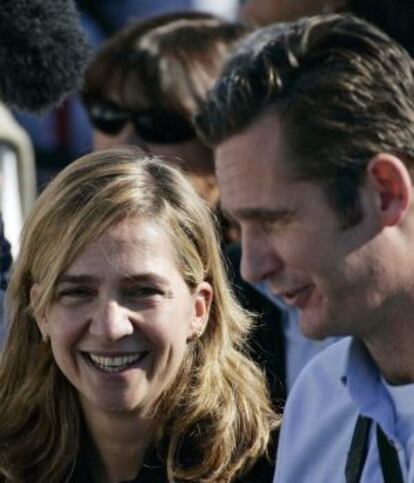Princess Cristina, from plain sailing to the tempestuous waters of justice
After a cosmopolitan early life, the king’s youngest daughter has been caught up in her husband’s murky affairs

All attempts to keep Princess Cristina out of the unfolding Nóos case have ultimately proven in vain. Her naming as an official suspect (imputar) by the judge investigating the business dealings of her husband, Iñaki Urdangarin, is merely a procedural concept that carries no more practical consequences other than her obligation to appear in court with her lawyer, but has nonetheless brought the matter to the very gates of the Royal Palace.
Born in Madrid on June 13, 1965, Princess Cristina is the youngest daughter of King Juan Carlos I and Queen Sofía. She is seventh in line to the throne after her brother Felipe, the prince of Asturias, his daughters Leonor and Sofía, her sister Elena and her two children, Felipe Juan Froilán and Victoria.
In 1989 Cristina became the first member of the Spanish royal family to earn a degree, in Political Science, at the Complutense University in the capital. A year later she gained a Masters in International Relations at the University of New York.
In 1991, she worked for several months as an intern at the Unesco headquarters in Paris. She remains linked to the organization as honorary president of its Spanish commission.
The princess combined her studies with her passion for sport and represented Spain in sailing at the 1988 Seoul Olympics, where she was also the flag bearer at the opening ceremony.
The royal couple returned to Spain in September 2012 so that the duke could face the accusations
Of all the royal family, Cristina is most intrinsically linked to Catalonia, with the exception of her late grandfather, the Count of Barcelona. She moved to the northern region in 1992 and a year later joined La Caixa Foundation, where she headed its social works department. Her engagement to Iñaki Urdangarin was made public on April 30, 1997.
The future duke of Palma was a member of the national handball team at the 1992 Barcelona Olympics. The wedding took place on October 4 in the Cathedral of Barcelona in front of more than 1,500 guests, among them members of over 40 royal households. The couple have four children: Juan Valentín, Pablo Nicolás, Miguel and Irene.
In 2009, the Duke and Duchess of Palma moved to Washington. At the time the royal relocation was explained by Urdangarin’s appointment as telecoms giant Telefónica’s international advisor. It later transpired that it was born of a desire to place distance between the duke and the blossoming investigation into financial irregularities at the non-profit Nóos Institute, a sports-promotion organization of which he was president.
It turned out to be a vain attempt as the ramifications of the Palma Arena corruption case — the investigation into alleged corruption and embezzlement of tens of millions public funds designated for the construction of a cycling circuit that went spectacularly over-budget — eventually resulted in Urdangarin coming to the attention of the judiciary at the end of 2011.
The royal couple returned to Spain in September 2012 so that the duke could face the accusations, during which time and since the princess has not left his side despite speculation that a reputation-saving separation was in the offing.
Both were removed from the list of royal duties scheduled for the monarch and his family to attend and Urdangarin has largely been kept at a gartered arm’s length from La Zarzuela Palace, which has been the source of negative media attention recently after the king’s ill-fated elephant hunting trip to Botswana, where he fell and broke his hip one year ago. The Royal Household has also been obliged to publish its accounts online in an effort to offer a greater level of transparency — an undertaking embarked on a month after the Nóos scandal broke. In another embarrassing incident last year, Froilán, 13, managed to shoot himself in the foot with a gun he was not legally allowed to handle. Quite the metaphor for the monarchy’s current plight.
Tu suscripción se está usando en otro dispositivo
¿Quieres añadir otro usuario a tu suscripción?
Si continúas leyendo en este dispositivo, no se podrá leer en el otro.
FlechaTu suscripción se está usando en otro dispositivo y solo puedes acceder a EL PAÍS desde un dispositivo a la vez.
Si quieres compartir tu cuenta, cambia tu suscripción a la modalidad Premium, así podrás añadir otro usuario. Cada uno accederá con su propia cuenta de email, lo que os permitirá personalizar vuestra experiencia en EL PAÍS.
¿Tienes una suscripción de empresa? Accede aquí para contratar más cuentas.
En el caso de no saber quién está usando tu cuenta, te recomendamos cambiar tu contraseña aquí.
Si decides continuar compartiendo tu cuenta, este mensaje se mostrará en tu dispositivo y en el de la otra persona que está usando tu cuenta de forma indefinida, afectando a tu experiencia de lectura. Puedes consultar aquí los términos y condiciones de la suscripción digital.
Últimas noticias
Maduro pleads not guilty before the federal court in New York: ‘I am still the president of Venezuela’
A new test can detect Alzheimer’s from a finger prick
UN team enters Sudanese city of El Fasher after paramilitary massacre: ‘It’s like a ghost town’
A recipe for resistance: Indigenous peoples politicize their struggles from the kitchen
Most viewed
- Gilles Lipovetsky: ‘If you want to live better and fall in love, take Prozac, don’t look to philosophy’
- Alain Aspect, Nobel laureate in physics: ‘Einstein was so smart that he would have had to recognize quantum entanglement’
- Alvin Hellerstein, a 92-year-old judge appointed by Bill Clinton, to preside over Maduro’s trial in New York
- Why oil has been at the center of Venezuela-US conflicts for decades
- Cuba confirms death of 32 of its citizens in the US attack against Venezuela








































